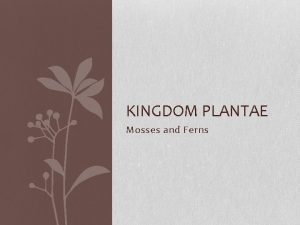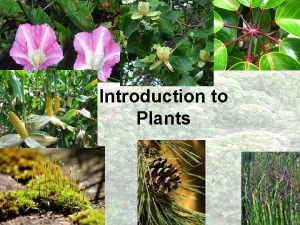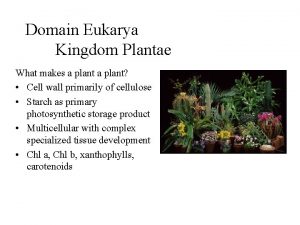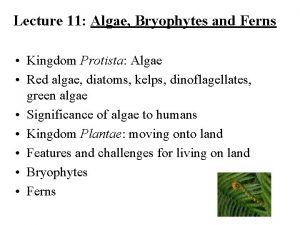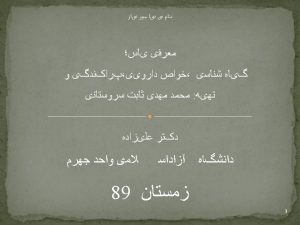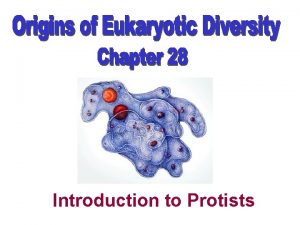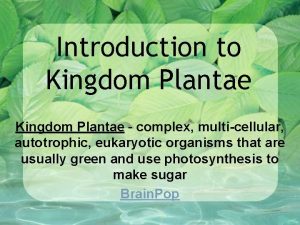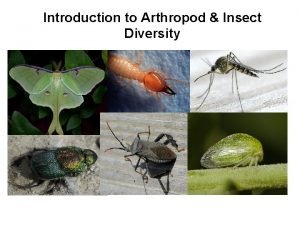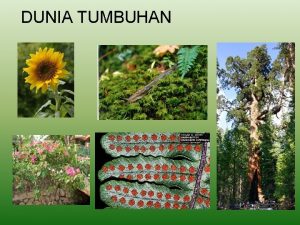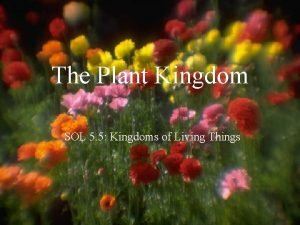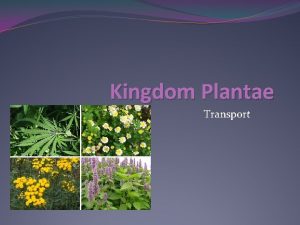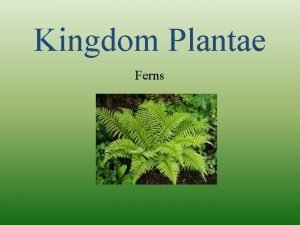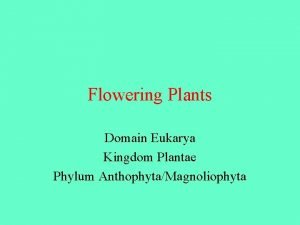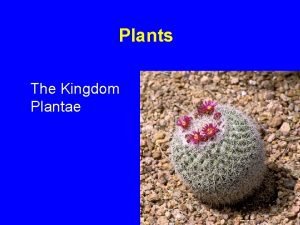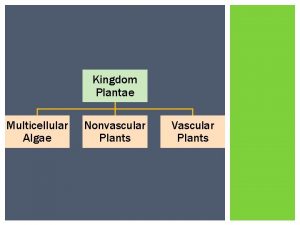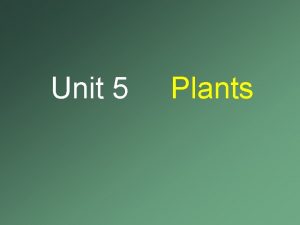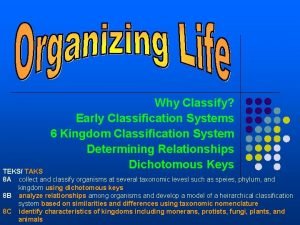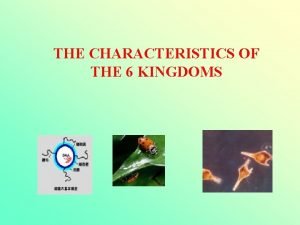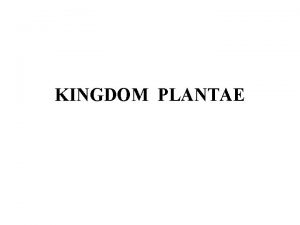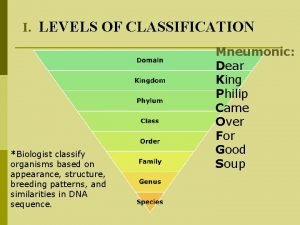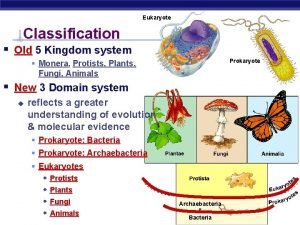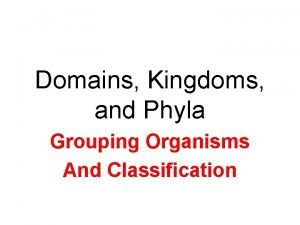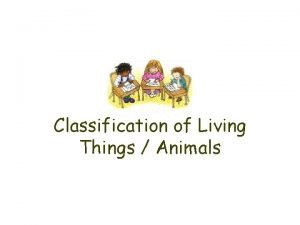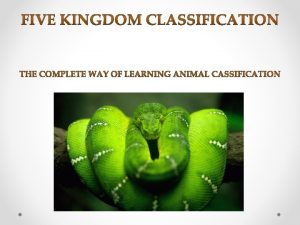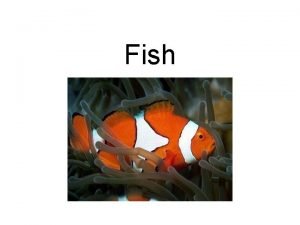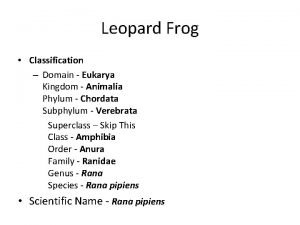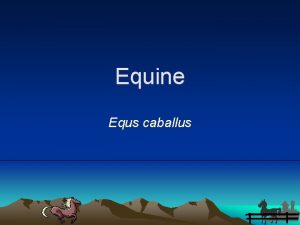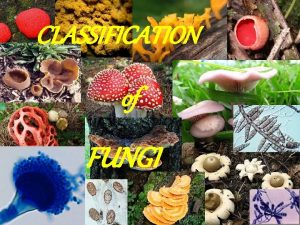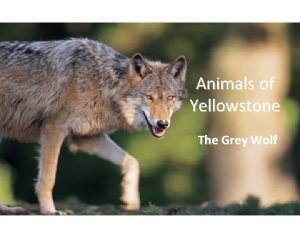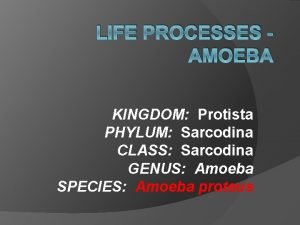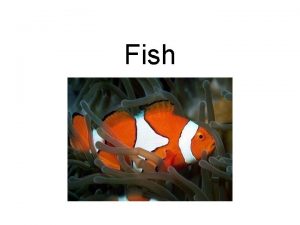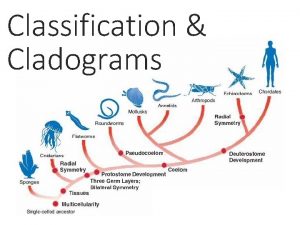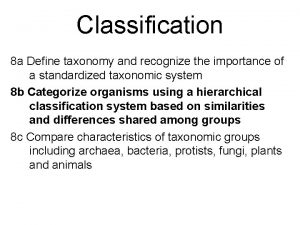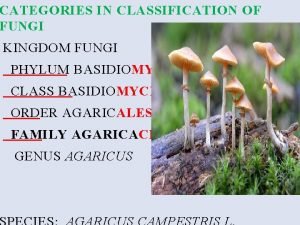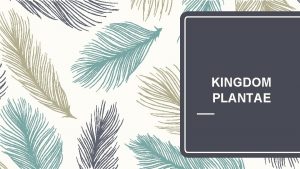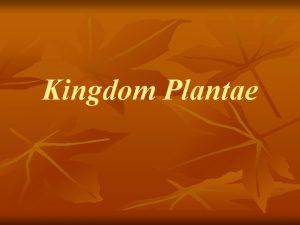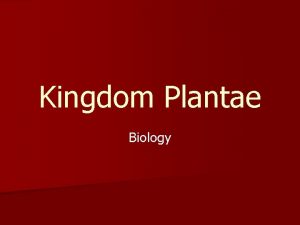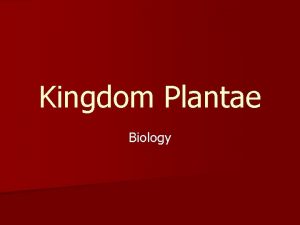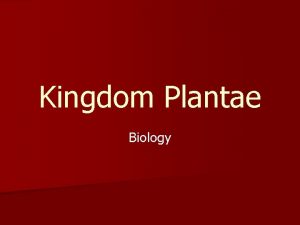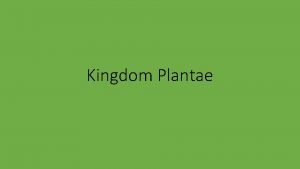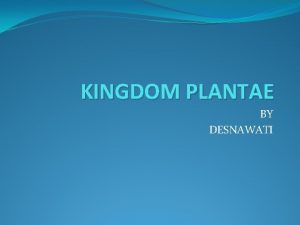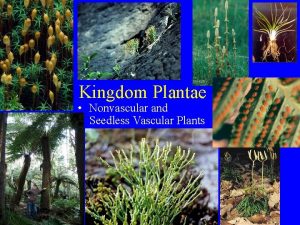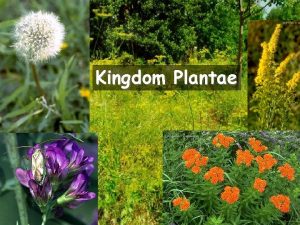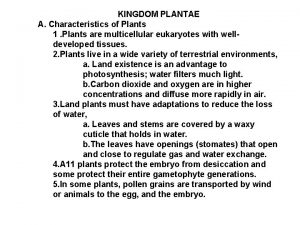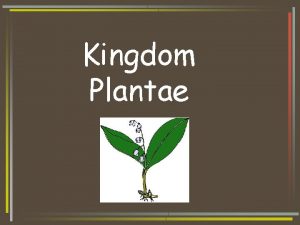Introduction to Plants Classification of plants Kingdom Plantae





























































- Slides: 61

Introduction to Plants

Classification of plants • Kingdom Plantae – Phylums • • • Lycodiophyta (Club Mosses) Equisetophyta (Horsetails) Psilotophyta (Wisk Ferns) Polypodiophyta (Ferns) Cycadophyta (Cycads) Ginkgophyta (Ginkoes) Pinophyta (Conifers) Gnetophyta (Vessel-bearing Gymnosperms) Magnoliophyta (Flowering Plants)

Facts… • critical to other life on this planet because they form the basis of all food webs • Most plants are autotrophic • earliest fossils found have been aged at 3. 8 billion years • scientific study of plants, known as botany • identified about 350, 000 extant (living) species of plants – ~258, 650 are flowering and ~18, 000 bryophytes

What are plants? • Multi-cellular organisms • Make own food (photosynthesis) • Have chloroplasts • Have rigid cell walls made of cellulose • Found all over the world

Plants provide: • • Food Oxygen Medicines Building materials • Textiles (fibers) • Coloring pigments

Plant Classification

Plants Without Seeds • Need water to reproduce • Reproduce with spores • Include – Mosses – Ferns – Horsetails – Bladderworts

Plants with Seeds • 2 types • Found all over the world

Gymnosperms • Means “naked seed” • Often have cones & needle-like leaves • Do not have flowers – Ex: conifers, gingko

Angiosperms • Flowering plants • Largest group – Moncots – Dicots

Monocots

Dicots

Evolution • Principal photosynthetic organisms were microscopic cells floating below the surface of the water, closer to the sun’s rays • As they multiplied, depleted resources of the open ocean, so colonies could be found nearer to the shores, in order to get minerals and nutrients from runoff • About 650 million years ago, diversity of these organisms abounded on the rocky shores, and some even integrated into multicelluar bodies

Evolution • These new multicelluar photosynthetic forms developed a cell wall due to the rough waters of the rocky coastline • As size increased, they developed internal structures that linked the photosynthesizing parts to the nonphotosynthesizing parts

Evolution to land. . • Oxygen & carbon dioxide not as abundant in the water, as it is not as free circulating as it is on land • Critical factor to adapting to land is water resources • Development of root systems to be able to keep plant stable on land to seek out water resources without moving

Warm UP • What is a seed?

SEEDS

What is a Seed? • A living organism that is dormant • Has the new plant inside • Part of the plants reproduction • Develop in the pistil of the plant – Develops from the ovule • Living thing! • Once fertilized zygote grows forming the embryo of the seed

What does it mean to be dormant?

Seeds are Dormant… • they remain alive though metabolically inactive and incapable of germination until the proper conditions to awaken it. • The seed is supplied all that it needs to germinate. • Seed dormancy is a mechanism that insures the survival of the species. To "Mother Nature", dormancy is a blessing that insures the continuation of the species over time and through periods of environmental stress.

Seed Dormancy Mechanisms

Hardseededness • Hardseededness is where the seedcoat surrounding the seed is the physical barrier to the uptake of water. • Physical scaring; or freezing and thawing may be needed to allow water uptake and germination to proceed.

Impermeable Membranes • Seed is impermeable to water uptake and oxygen uptake. • Generally, cool temperatures allow oxygen to make its way into the seed while warm temperatures prevent oxygen uptake. – Since germination is fueled by the respiration of stored food within the seed, without oxygen, germination cannot occur.

Inhibitors and Promotors • Dormancy due to inhibitors is based upon the fact that germination and growth promoting enzymes and hormones can be inhibited, thus preventing germination. • These inhibitors are found in the endosperm, cotyledons, or other food storage tissue. Sometimes these chemicals are found in the outer coverings of the seed or fruit.

Light and its Role • Many seed species with small seeds need light to germinate. When buried deeply in the soil, they lack the light and go dormant. This can be seen in your garden where you think you have gotten rid of the weeds and then you disturb the soil. This disturbance brings seeds to the surface where they are stimulated by the light and begin to germinate.

Seed Diagram Endosperm provides FOOD! Hypocotyl Epicotyl Radicle

Seed Embryo • Has parts of a complete plant – Leaves • Epicotyl, plumule – Stems • Hypocotyl – Roots • Radicle – FOOD • Endosperm, or cotyledon

Seed Embryo Anatomy • Radicle : the lower end of the hypocotyl that forms the first root of the plant. – Emerges 1 st at the start of germination • Hypocotyl: develops into true stem • Epicotyl/Plumule: first leaves!

Seed Embryo Anatomy • Endosperm: provides food for growing seed embryo • Cotyledons: store food absorbed from the endosperm when the seed was formed • Seed Coat: surrounds the seed and protects it from injury and dehydration

Germination • Definition: process by which an embryo plant inside the seed changes into a developing seedling – Crops grown from seeds: soybean, corn, cotton and other vegetables !

Germination: Steps • Step 1: Absorption of Water and Oxygen! – By Diffusion – Pressure Builds • Pressure in seed (and adult plant) is called TURGOR – Seed ruptures • Step 2: Radicle Emerges – First root/tap root

Germination: Steps • STEP 3: After the root absorbs water, an embryonic shoot emerges from the seed. – This shoot comprises three main parts: the cotyledons (seed leaves), the section of shoot below the cotyledons (hypocotyl), and the section of shoot above the cotyledons (epicotyl). – The way the shoot emerges differs among plant groups.


What’s Required For Germination? • WATER! • Optimum temperature – 55 and 70 degrees F • Oxygen – Too much water can suffocate the plant • Some require Stratification – A period of cold temperature • Broken seed coat – Digestive Bacteria, eaten by an animal, Frozen thawed

WHAT TO COMPLETE… • Seed Dissection Lab… • Seed Planting. . You will get some seeds and a cup. Soil is available to plant your seeds. Be sure to put your name on your cup! • P. 577 foldable… • All due by the end of the period

Roots What do they do for the plant? ? ?

Are you Rooted? • Roots help to keep plants in place. • They spread out into the soil and “attached” themselves to the particles of the soil. • Why do they reach and probe? – To find nutrients and water, thus in the end the plant gets anchored into the soil.

Are you Rooted? • Plants get the water they need for photosynthesis through their roots. • The roots have a type of cell called a root hair cell - these project out from the root into the soil. Roots have a big surface area and thin walls, which allow water to pass into them easily. • Note that root cells do not contain chloroplasts, as they are normally in the dark and cannot photosynthesis.

Are you Rooted? • The water absorbed by the root hair cells passes through the plant in xylem tubes, and eventually reaches the leaves. If a plant does not absorb enough water, it will wilt or go floppy. Without water it may also not photosynthesis quickly enough, and it may die.

Root Hairs • Water in the soil is taken up by root hairs and then passes from cell to the xylem.

Types of Roots Fibrous Roots • Generally grasses have this type of root • Many roots extend into the soil from base of plant Tap Roots • One or more large roots extending into the soil • Smaller roots branch off

Types of Roots • Shallow roots – Desert roots – Quickly growing plants • Deep underground roots – Areas with little rainfall • Deep and Shallow Roots – Takes advantage of underground water sources and occasional showers.

Root Growth What does it depend on? • Amount of moisture in the soil • Type of soil • How quickly the plants grow and go to seed • Type of rainfall in that area • Type of plant – prop roots are used to help support the plant

Lastly… • Roots are used as food storage for plants. They store sugars and starches to help plants over winter. • Sugar storage in roots also help to send up new shoots each spring, and to regenerate stems and leaves that were eaten or burned. • Radishes, carrots, turnips – store large amounts of food in the form of starch in their roots. We eat these roots as a source of energy.

Plant Functions What do stems & leaves do for a plant? ? ?

Stems also carry water and minerals up from the roots to the leaves to help with photosynthesis and take food back down to be stored and distributed to the plant as it has need. The stem is a part of the plant that holds up other structures such as the leaves and flowers. This is important as the leaves need to be held up to the sun to get its light for photosynthesis and the flowers need to be held up to be available for pollination.

Stems The tubes in the stem that take the water and minerals up into the plant are the xylem and the tubes that carry the food back down are called the phloem.

Transport of Materials • Phloem (2) – Carries sugars (food) up & down in plant • Xylem (1) – Carries water & mineral up from roots to all parts of plants

Leaves The leaf is a part of the plant that is charge of making food for the plant. This food making process is called photosynthesis.

Parts of the leaf • Petiole - a thin stalk that connects the blade of the leaf to the plant's stem. These veins are called • Blade - a thin, flat part of the leaf that extends off the end of the petiole. It is green as it contains chlorophyll which is necessary in making the plant's food.

Primary vein: is the main vein starting at the base of the leaf. It is noticeably wide than the other veins. Secondary veins: veins usually branching off the primary vein, are noticeably narrower than the primary vein.

Leaf Cross Section • Plants get carbon dioxide from the air through their leaves. The carbon dioxide diffuses through small holes in the underside of the leaf called stomata.

Leaf Cross Section • The lower part of the leaf has loose-fitting cells, to allow carbon dioxide to reach the other cells in the leaf. This also allow the oxygen produced in photosynthesis to leave the leaf easily.

Leaf Cross Section • A leaf usually has a large surface area, so that it can absorb a lot of light. Its top surface is protected from water loss, disease and weather damage by a waxy layer. • The upper part of the leaf is where the light falls, and it contains a type of cell called a palisade cell. This is adapted to absorb a lot of light. It has lots of chloroplasts and is shaped like a tall box.

y Photosynthesis Su ne ne rg • Leaves collect sunlight, water and carbon dioxide to make sugar (food) for the plant • The chemical equation for this process is • 6 H 2 O + 6 CO 2 C 6 H 12 O 6 + 6 O 2 sugar

• Leaves break down sugars to get energy • This process releases excess water as waste • The chemical equation is C 6 H 12 O 6 + 6 O 2 energy + 6 H 2 O + 6 CO 2 sugar To help plant grow Energy released Respiration

Transpiration • Taking in CO 2 and releasing O 2 and H 2 O as waste products after respiration



Angiosperms • Monocots – Has 1 food part – Parallel veins – Petals in groups of 3, 6, 9 – Xylem & phloem scattered throughout stem

Angiosperms • Dicots – Have 2 food parts – Net-like veins – Petals in groups of 4 or 5 – Xylem & phloem are ring-like in stem
 Protista mobility
Protista mobility Plantae kingdom drawing
Plantae kingdom drawing Domain of kingdom protista
Domain of kingdom protista Introduction of kingdom plantae
Introduction of kingdom plantae Old kingdom middle kingdom new kingdom
Old kingdom middle kingdom new kingdom Nnn ruled
Nnn ruled Old kingdom middle kingdom new kingdom
Old kingdom middle kingdom new kingdom Old kingdom middle kingdom new kingdom
Old kingdom middle kingdom new kingdom Phylogenetic tree grade 11
Phylogenetic tree grade 11 Characteristics of mosses and ferns
Characteristics of mosses and ferns Main characteristics of plantae
Main characteristics of plantae Plantae kingdom
Plantae kingdom Endodermis
Endodermis Animalia fungi plantae
Animalia fungi plantae Characteristics of organisms in kingdom plantae
Characteristics of organisms in kingdom plantae Archaebacteria characteristics chart
Archaebacteria characteristics chart Protista prokaryotic
Protista prokaryotic Green algae structure
Green algae structure Animalia cladogram
Animalia cladogram Subkingdom tracheobionta
Subkingdom tracheobionta Chlorophyta prokaryotic eukaryotic
Chlorophyta prokaryotic eukaryotic Multicellular eukaryotic autotrophic organisms
Multicellular eukaryotic autotrophic organisms Kingdom plantae chart
Kingdom plantae chart Struktur selaginella sp
Struktur selaginella sp Diagram of kingdom plantae
Diagram of kingdom plantae Characteristic of plantae
Characteristic of plantae Guard cells
Guard cells Equisitem
Equisitem Flowering plants phylum
Flowering plants phylum Common characteristics of plantae
Common characteristics of plantae Plantae kingdom
Plantae kingdom Is algae non vascular
Is algae non vascular The odds and ends kingdom
The odds and ends kingdom ไนนก
ไนนก Vascular plants vs nonvascular plants
Vascular plants vs nonvascular plants Non vascular vs vascular plants
Non vascular vs vascular plants Features of non flowering plants
Features of non flowering plants C3 plant
C3 plant Paramecium kingdom classification
Paramecium kingdom classification 6 kingdom classification
6 kingdom classification What are the 6 kingdoms of living things
What are the 6 kingdoms of living things Algae classification kingdom
Algae classification kingdom Characteristics of algae
Characteristics of algae Scientific classification of frog
Scientific classification of frog 5 kingdom classification chart
5 kingdom classification chart Horse taxonomy
Horse taxonomy Domains and kingdoms
Domains and kingdoms I am covered in dry scales and i lay eggs. what am i?
I am covered in dry scales and i lay eggs. what am i? Algae singular or plural
Algae singular or plural Classification of protista
Classification of protista Kingdom animalia fish
Kingdom animalia fish External nares frogs
External nares frogs Horse classification kingdom
Horse classification kingdom Kingdom mycota classification
Kingdom mycota classification Wolf genus and species
Wolf genus and species Zoological classification of cow
Zoological classification of cow Phylum sarcodina
Phylum sarcodina Fish kingdom classification
Fish kingdom classification Common characteristics of the six kingdoms of life
Common characteristics of the six kingdoms of life Define classification
Define classification Mushroom phylum
Mushroom phylum Balanoglossus systematic position
Balanoglossus systematic position









